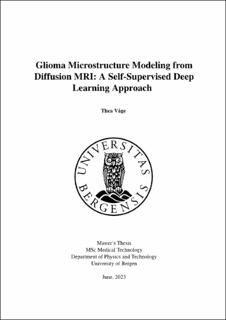| dc.description.abstract | Purpose: Gliomas are a highly heterogeneous group of primary brain tumors with poor prognosis, and treatment monitoring is challenging with its current diagnostic tool being invasive biopsy. In recent years, diffusion-weighted magnetic resonance imaging (dMRI) has become a widely used non-invasive technique that infers tissue microstructure in tumors. Such analysis presents opportunities in cancer diagnosis, tumor grading, and monitoring treatment effectiveness. A technique called vascular, extracellular and restricted diffusion for cytometry in tumors (VERDICT) has been demonstrated to be feasible for inferring glioma microstructure, but current methods are time-consuming in terms of acquisition and analysis and therefore not clinically applicable. In this thesis, the purpose was therefore to investigate whether VERDICT microstructure fitting in glioma tissue could be approached with a newly introduced self-supervised fully connected neural network method. Methods: A large-scale synthetic dataset was simulated using the VERDICT signal equation based on known ground-truth glioma tissue parameters, with a highly detailed acquisition protocol. A feed-forward neural network (FFNN) was constructed to predict four tissue parameters from dMRI signals: the cell radius, intracellular (IC) volume fraction, extracellular-extravascular (EES) volume fraction and vascular volume fraction. The network was trained and tuned on the large-scale simulated dataset before it was trained on clinically applicable sequences and tested on in vivo dMRI. Furthermore, experiments were conducted to test the network’s performance with different acquisition protocols, aiming to determine the potential improvement that could be achieved through protocol optimization. Lastly, the proposed ANN was compared to existing methods in terms of computational time and accuracy. Results: The model trained on the large-scale synthetic data managed to estimate the four parameters with high precision, and the prediction time in one voxel was less than 10−4 s when applying a trained network to an in vivo dMRI. Predictions on acquired in vivo data were compatible with tissue parameters from the literature for a longer dMRI scan, but the model showed lower accuracy in terms of fitting data with a shorter acquisition (i.e. less rich diffusion protocol). From experimenting with different acquisition protocols, the best performance was found on the longest protocol, but it was found that the accuracy of predictions was also dependent on the individual acquisition parameter ranges. Conclusion: This project successfully demonstrated the ability to use the FFNN approach to fit the VERDICT model to dMRI data. Findings indicated that the FFNN fitting is heavily influenced by the acquisition protocol, and the method is not suitable for MRI acquisitions with less than 20 measurements. However, the method showed good potential for use in acquisitions with 436 measurements, and for predicting a radius of up to 10 µm, 145 high b-value measurements can be sufficient. Optimization of the acquisition schemes suggested that alternative schemes could further enhance the effectiveness of the technique. The FFNN showed several advantages in terms of computational time and accuracy of predictions compared to existing methods. | |
